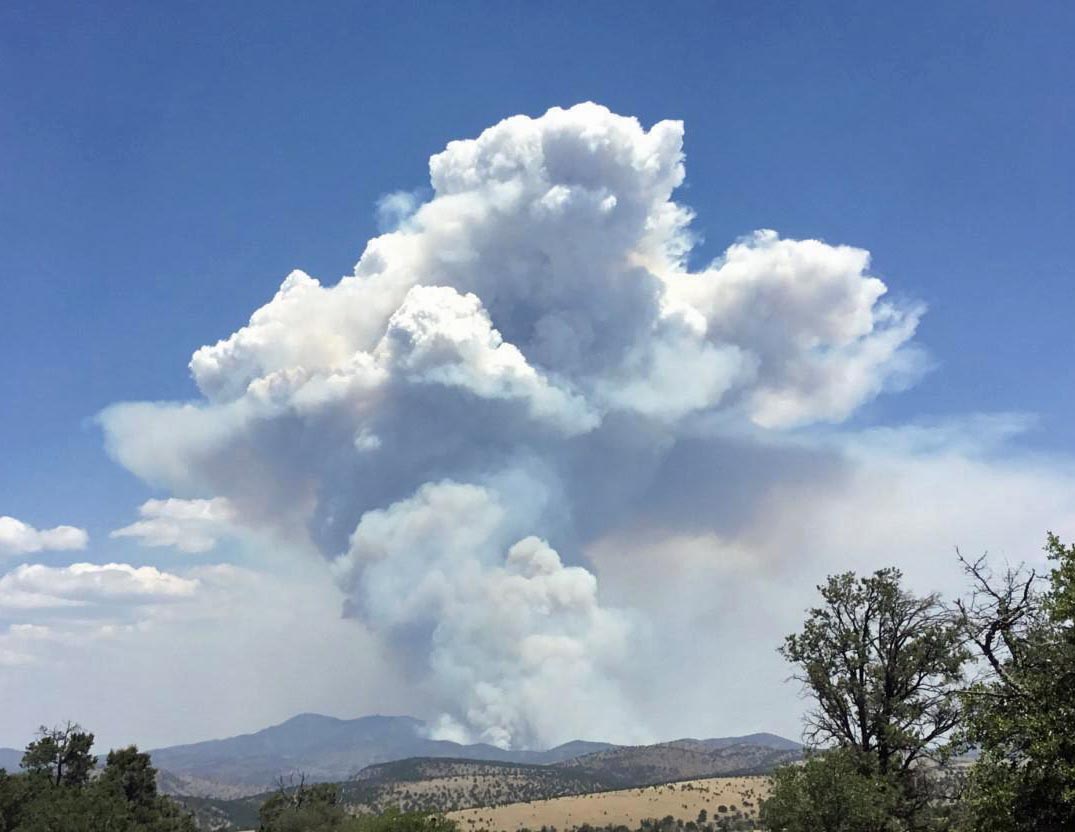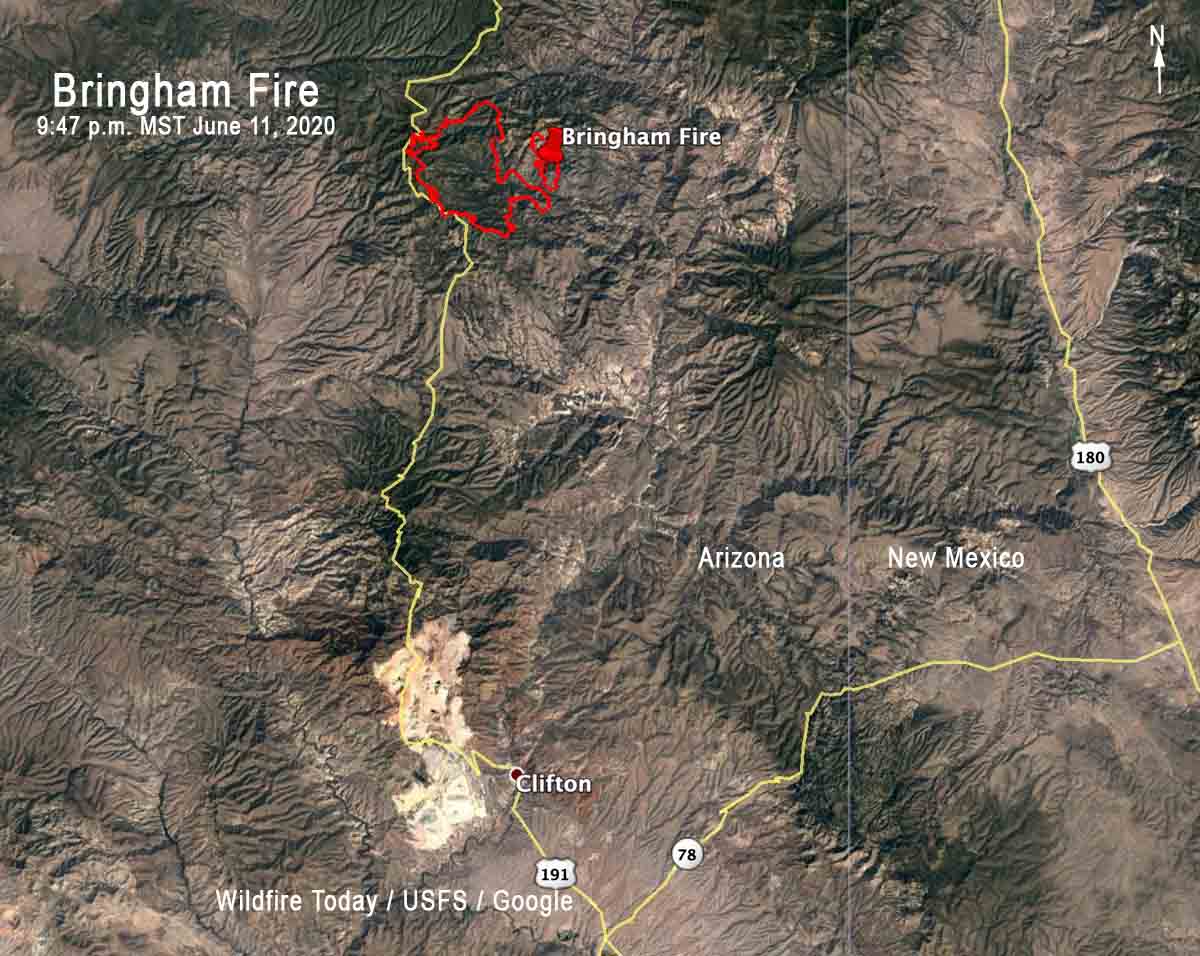
After exhibiting moderate growth since it started from a lightning strike on June 6, the Bringham Fire in eastern Arizona more than tripled in size Thursday. It was mapped Wednesday night at 3,318 acres, and 24 hours later an infrared mapping aircraft determined it had grown to 10,803 acres.
The fire is 23 air miles north of Clifton, Arizona and 27 air miles southwest of Alpine, Arizona. Values at risk that have been identified include the highway, area cabins, Rose Peak lookout, campgrounds, natural and cultural resources, and threatened and endangered species and their habitat.

Firefighters have been conducting burnout operations in an attempt to keep the fire east of Highway 191. Portable water tanks have been set up along the highway to support helicopter operations in this effort.
Resources on the fire include 4 hand crews, 1 initial attack crew, 4 engines, 2 water tenders, 3 helicopters, plus various incident management overhead.

Fire season is off and running in a couple of the Four Corners states. Many / most I assume are USFS jurisdiction, like this Brigham fire. Several have become significant size wise. This Brigham fire for sure… “Bringham Fire triples in size in 24 hours”.
I recall reading the details presented within the Fed/USFS plans for dealing with wildfires in the age of COVID19. I think I remember reading that their plans emphasized aggressive initial attack. (A tacit admission that in the past they have not assigned a high priority to initial attack perhaps?)
So I’m curious… anybody directly involved, or closely observing, seeing any difference in the way the Feds are responding, initially? Fire numbers, growing acreage totals and headlines might lead someone to believe that nothing has changed much as far as their initial attack ops go. Just look at the list of resources noted in this article… 10,000 acre fire: 1 initial attack crew, 4 hand crews; 4 engines, 2 water tenders, 3 helicopters. Where I come from that’s not even half of an IA dispatch for a first report of roadside wildland fire.
But, it’s too soon to tell here locally, where historically the Stanislaus has been painfully slow to respond; the Rim and Donnell being two recent examples of slow and criminally inadequate IA.
Are they doing any better in Arizona or New Mexico? For residents, neighboring private land owners and tax payers far and wide, I hope so.
Having worked on the ranger disttict where the Bringham fire is taking place, perhaps I could shed some light on why this fire is the size it is. If you look at the satellite map in the article, you’ll see the 191 road directly west of the incident. That is quite literally the ONLY road in a very large part of the district. There are not even any driveable two-tracks in the area of the fire (aside from the one up to Rose Peak lookout, which is less than a mile off the highway). The cabins mentioned in “values at risk” are all historic and long-abandoned cabins in the Blue Range Primitive Area, not currently occupied vacation homes. And the district’s lone fire resource is a 7-10 person IA hand crew, who depending on the day, work either out of the district office (1.5-2 hours south of the fire) or the Strayhorse Work Center (about 1 hour norh of the fire) the next closest ranger district office with resources is an additional 45 minutes from Strayhorse. The terrain on his district is also incredibly steep, rugged, and unforgiving.
Basically, it’s probably one of the most isolated non-wilderness places in R3, and if a fire has any movement potential there, usually the only strategy available is to use 191 as a holding feature and herd it around until the rains come.
I have a family member on that fire. Most people don’t realize that you can’t just drive in an put the fire out. Hiking in with a pack is hard work not to mention the higher altitude. Twenty four hour shifts and sleeping under the stars is not a job for anybody. Thank you fire fighters!
Fifty years ago, I was one of those hiking into the fire. You are so right, it is not for the faint of heart.
Thank you firefighter’s for doing what is necessary to protect our wildlands for us and future generations.
It is a difficult area to respond to. There is no occupied structures from the Hannigan Meadows lodge south to about to the Morenci mining city. No food. No gas. Not much potable water. 70 0f the most desolate miles in the western US. I just got off this fire due to another assignment. The southwest is currently in a Preparedness Level 4 which means available resources to respond to any fire are scarce at best. Worst case you have to manage with less qualified people and resources. Add other large fires in the same response area… New Mexico, Kiabab, Tonto NF, Coconino NF. Who takes precedent? A fire in a densely populated area that’s frequented by millions of people a year like the Tonto, Tucson, or the grand canyon… or does a desolate patch of no mans land between a Native American reservation and a New Mexican wilderness. You could probably figure it out. So Land managers are left with whatever mixed bag of tricks the region is willing to spare. Then add covid to mix. Tight federal guidelines, social distancing between personnel and crews. making the greatest priority “not catching covid” and you can see why this season started extremely slow and one week later its like cannon went off. As if we didnt have enough stress and danger to worry about on the fireline now firefighters are handcuffed in their fight. I agreed to protect people and land from fire not from covid but now it seems I must do both.